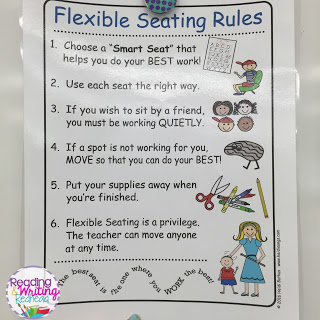
Keep the “Flex” in Flexible Seating: Why Traditional Student Desks and Chairs Still Matter

Optional seating, alternative seating, flexible seating. No matter what it’s called, many K-12 educators are rushing to provide nontraditional student seating options.
But how students position themselves to learn is as different as their individual learning styles. For some students, traditional student desks and student chairs still work best physically, cognitively, socially and emotionally.
This blog addresses why moderation is the smartest way to approach the mad-dash to flexible seating. Indeed, there is still a welcomed place for K-12 traditional student desks and chairs, albeit, with a modern, light-weight look and feel.
Below, is what some teachers, education bloggers and parents are saying about the trend. The gist: Alternative seating should be what the name implies – an alternative, not the norm. Here’s why.
Looking for more information on the Flexible Seating?
Download our Flexible Seating guide.
Download Flexible Seating Guide
Preferences Vary
Removing every desk and chair is a huge change. That may not work for all students, nor how they learn best, explained Bonnie Kathryn Hunter, a kindergarten teacher. She says that some students need a more ‘formal’ position to switch their brains into learning mode.
“I see teachers taking it to the extreme and moving everything out except maybe a reading table. I know that would not work for my classroom,” she said. In her opinion, some students find a more traditional desk-chair most comfortable, and where they are most engaged. “Camp-style chairs and floor pillows aren’t for everyone.”
Also, keep in mind that flexible seating must be in compliance with student IEPs and 504 plans. Furthermore, many kids who struggle with anxiety or fall on the autism spectrum, a predictable seat and personal space are important.
Safety
Safety is a top concern when schools begin modifying existing classroom furniture or teachers bring in random odds-and-ends furniture. Are these alternatives durable, stable and capable of being sanitized (think lice, illness, etc.)? The same goes for floors and carpets where students sprawl out.

Safety is the first priority for K-12 furniture manufacturer Smith System®. It recently introduced Oodle, a stackable stool that gives students the option to sit still or use ten degrees of multi-directional rocking motion. A sturdy rotation lock keeps the proprietary stack-and-lock system securely fastened. The rocking base features a “stop” at its perimeter, so students know they’ve rocked as far as able.
Body Ability and Comfort
Childhood obesity is at an all-time high. Students’ flexibility, muscle tone and comfort can greatly vary. All the more reason to keep some traditional seating options, as this teacher concluded:
“My first graders loved alternative seating last year! I did leave eight traditional desks and chairs as a choice. There were several kids that sat at those each day. Options are important. You have to take into consideration so many things, but one I hadn’t thought about was body type. It was not comfortable for some of my larger kids to sit on the floor or at a seat with no back.”

Flexible seating and comfort is a two-way street. Just as some kids aren’t comfortable in traditional seating all day, some aren’t comfortable in flex seating all day. Students need options to switch things up.
Posture
Coffee-shop-style casual seating is comfortable and novel, at least for one cup of coffee. But bodies, especially growing bodies, need some back support to prevent bad posture and bad habits.
One teacher went as far to say this about some flexible seating options, “Does anyone care about these kids’ backs and posture? Sitting hunched on a flat cushion on the floor at a low table makes no sense to me. Some of these choices are irresponsible.”
While it’s hard to find formal research on flexible seating and posture, studies do show that correct posture improves blood flow, which, in turn, improves concentration and learning. That is, as long as students are not holding a rigid posture for too long.
Smith System® solves this dilemma with its many active seating options that support posture, movement, and comfort. A prime example is Smith’s Flavors Chair. It provides four-directional seating, with a slight flex in the seatback and seat pan. Students can freely adjust their posture, without compromising it.
Parental Buy-In
Getting a principal to pre-approve flexible seating is essential. But so is parental buy-in. Don’t assume parents and guardians are ready to toss the tables, desks, and chairs. Here’s what a few parents said online:
Parent One
"My daughter’s fourth grade teacher had no chairs, only tables lowered, so they had no option but to sit on the floor. She [the teacher] wasn’t considering the fact that some children wouldn’t be comfortable sitting on the floor all day long, just as students aren’t comfortable sitting in a chair all day long!”
Parent Two
"I don't like that the teacher removed all of the traditional desks. I don’t want my child in third grade to be on the floor and develop bad posture/habit. Supposedly it is ‘alternative,’ but the teacher took out the ‘norm’. I can’t believe the school board/ principal would approve such radical change in the instructional facility. Parents were not involved in this decision.”
To educate parents on seating, some teachers hosts an open house or send home information for parents to sign. (Be prepared to answer questions about effective classroom management with flexible seating, i.e., can students handle the autonomy.)
What About Next Year?
Obviously, not every teacher or classroom that a student encounters will have flexible seating options. Students must be flexible, in the very literal sense, to learn in a variety of environments. This kindergarten teacher makes sure of it:
“My 26 kindergarten students each have a traditional chair at a table. They also sit on the Story Rug, lay on tummies to write with clipboards, sit on small group stools, stand, etc. I know it is harder for the teachers in the next grade level if these kiddos have never done classwork in traditional seating -- tough transition!”
Tamara Russell is a third grade teacher in Central Florida and author of “Mrs. Russell’s Room” blog. She has a more practical opinion.
“At the end of the day, no student is going to be asked to sit on a yoga ball while doing a job interview, but they will need to learn how to sit in a chair and talk without showing their nerves.”
Budget
Completely converting to an all-flexible-seating classroom can be seen as wasteful. The process must be thoughtful on a financial, environmental and practical level. Many teachers blend in a few flexible seating options and stop there, like this teacher:
“I’m considering adding some more seating choices in next year, but because we have a newly remodeled building, we have to keep the new furniture.” She and her coworker and are thinking about writing a grant to fund some alternative seating.
Standardized Testing Requirements
Standardized tests have strict seating requirements. For example: chairs with backs, students facing the same direction, adequately separating students, smooth writing surface (preferably desks or tables), etc.
At test time, students are not allowed to sit on the floor, a futon, butterfly chairs or video rockers. Russell weighed in with more practical insight.
“The bottom line is those kids are going to be taking standardized tests in sterile environments where they all have the same seats. Kids have to get used to the fact that they have to perform important tasks in settings that may or may not suit them.”
Keep the Choices
If flexible seating is about giving students choices, think twice before ditching the tried-and-true traditional student desks and chairs. Fresh, modern traditional options do exist, as well as nontraditional winners that keep kids safe.
Take a look at the Smith System® lines of Flexible Seating and all of our Classroom Chairs lines.
Sources:
Categories
Recent Posts
 Employee Spotlight – Meet Manuel Paredes
Employee Spotlight – Meet Manuel Paredes How to Create a Dynamic Active Learning Environment with School Furniture
How to Create a Dynamic Active Learning Environment with School Furniture The Power of Choice–Platinum & Clear Totes Now Available
The Power of Choice–Platinum & Clear Totes Now Available Leaping into Latin America: Smith System Expands Furniture Footprint
Leaping into Latin America: Smith System Expands Furniture Footprint Furniture Overhaul Turns Special Ed Science Classroom into ‘Science Oasis’
Furniture Overhaul Turns Special Ed Science Classroom into ‘Science Oasis’ Leveraging Technology to Support Student Wellbeing
Leveraging Technology to Support Student Wellbeing Designing Flexible Learning Spaces for Ed Tech Integration
Designing Flexible Learning Spaces for Ed Tech Integration How Technology is Shaping the Future of Learning
How Technology is Shaping the Future of Learning
Recent Posts
- Employee Spotlight – Meet Manuel Paredes
- How to Create a Dynamic Active Learning Environment with School Furniture
- The Power of Choice–Platinum & Clear Totes Now Available
- Leaping into Latin America: Smith System Expands Furniture Footprint
- Furniture Overhaul Turns Special Ed Science Classroom into ‘Science Oasis’


